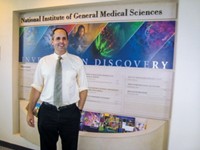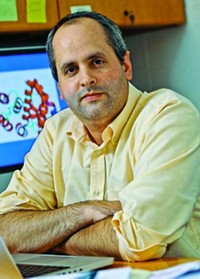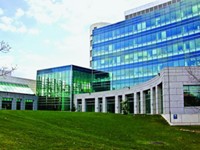Advertisement
Grab your lab coat. Let's get started
Welcome!
Welcome!
Create an account below to get 6 C&EN articles per month, receive newsletters and more - all free.
It seems this is your first time logging in online. Please enter the following information to continue.
As an ACS member you automatically get access to this site. All we need is few more details to create your reading experience.
Not you? Sign in with a different account.
Not you? Sign in with a different account.
ERROR 1
ERROR 1
ERROR 2
ERROR 2
ERROR 2
ERROR 2
ERROR 2
Password and Confirm password must match.
If you have an ACS member number, please enter it here so we can link this account to your membership. (optional)
ERROR 2
ACS values your privacy. By submitting your information, you are gaining access to C&EN and subscribing to our weekly newsletter. We use the information you provide to make your reading experience better, and we will never sell your data to third party members.
Policy
Movers And Shakers
Jeremy Berg’s Legacy At NIH
NIGMS director, champion of chemistry leaves an indelible mark
by Britt E. Erickson
June 20, 2011
| A version of this story appeared in
Volume 89, Issue 25

One of the foremost advocates for chemistry at the National Institutes of Health is stepping down at the end of this month. Jeremy M. Berg, director of the National Institute of General Medical Sciences (NIGMS), the top NIH institute for the support of chemical research, is taking a position at the University of Pittsburgh, where his wife, Wendie Berg, is a breast-imaging expert.
NIH has been seeking a replacement for Berg since he announced last December that he would be leaving (C&EN, Dec. 13, 2010, page 8). But when C&EN went to press, no one had been named to the position yet. NIH announced on June 13 that Judith H. Greenberg will serve as acting director of NIGMS while the search for a permanent director continues.
Berg, a chemist to the core, will indeed be hard to replace. During his seven-and-a-half-year tenure at NIGMS, he helped increase funding for new investigators and highly innovative biomedical research. He spearheaded the drafting of NIGMS’s first strategic plan and strived to boost training of extramural researchers funded by NIGMS. He also helped increase diversity in the biomedical workforce.
Berg is widely admired for his leadership and communication skills. He is particularly well-known for successfully finding middle ground between NIH and the American Chemical Society in 2004, when NIH decided to launch PubChem, a publicly accessible chemical structure database. Officials of ACS, which publishes C&EN, initially opposed the idea, worried that the free service would compete with their private database, the Chemical Abstracts Service Registry.
NIH Director Francis S. Collins recalls working closely with Berg on the PubChem project during negotiations with ACS. At the time, Collins was director of the National Human Genome Research Institute. The project, he says, “turned out to be a positive for everyone, even its original opponents.”
PubChem was a complex issue that created some tension, adds Glenn S. Ruskin, director of the ACS Office of Public Affairs. Berg “played a very important role in helping the two organizations talk to each other.”

Earlier this year, ACS honored Berg with its 2011 Public Service Award for his vision and leadership in science policy (C&EN, April 25, page 9). Berg is also the recipient of the 2011 Howard K. Schachman Public Service Award from the American Society for Biochemistry & Molecular Biology and was recently elected as ASBMB’s next president, starting on July 1, 2012.
“We are delighted to have such an outstanding leader take the helm of ASBMB next year,” says Suzanne Pfeffer, ASBMB’s current president and a biochemist at Stanford University. “Berg brings tremendous excellence in biochemistry and firsthand knowledge of the inner workings of NIH and key science policy issues.”
Other scientific societies also praise Berg for his accomplishments as a scientist and as a leader. “Berg is an extremely bright, confident, and creative scientist, and he used these talents well in his leadership of NIGMS,” says Howard H. Garrison, deputy executive director for policy and director of the Office of Public Affairs at the Federation of American Societies for Experimental Biology. “Open to a wide range of views, he encouraged an honest exchange of perspectives and was always willing to engage with the extramural community. He did not shrink from big or contentious challenges and often took bold steps to confront them.”
Appointing Berg to head NIGMS “was one of the best decisions I made while directing the NIH,” says former NIH director Elias A. Zerhouni. “He was critical in supporting innovative programs focused on encouraging high-risk, but high-impact” research. He also led many key initiatives at NIH, including the support of new investigators, who have typically had a hard time competing with more established researchers for NIH grants, Zerhouni notes. “He did it all with a keen sense for outstanding science and an unprecedented commitment to transparency.”
Berg says he really didn’t know what to expect when he took the helm at NIGMS in late 2003. “It was so different from anything that I had done that there wasn’t any really good way to figure it out except to decide it was worth doing and jump in with both feet,” he tells C&EN. Prior to joining NIGMS, Berg was director of the Institute for Basic Biomedical Sciences and chair of the department of biophysics and biophysical chemistry at Johns Hopkins University School of Medicine. He holds a Ph.D. in chemistry from Harvard University.
One of the primary reasons Berg assumed the responsibility of running a $2 billion institute at NIH was the budget climate in 2003. NIH had seen its budget double from 1998 to 2003, but he predicted that the trend was unlikely to continue. “Decisions were going to matter because budgets were going to likely get tighter, and I either had to accept the position or give up my right to complain,” he says.
Berg was right. The NIH budget and that of NIGMS have been essentially flat since 2003. “If anything, things are tighter than they were before,” he notes. The NIGMS budget was $1.85 billion in fiscal 2003, compared with $2.05 billion in fiscal 2010. “I think it is going to be a great opportunity for somebody to come in who really wants to make a difference because there are going to be some tough decisions to make,” he says.
During the NIH budget-doubling years, abundant new capital flowed into the biomedical field, and with ready access to funds, researchers thought they could hire many new people, Berg recalls. “There are now a lot more people competing for a pie that has actually gotten smaller in terms of the amount of science it can buy,” he says. As a result, success rates for NIH extramural research grants fell from 30% in 2003 to 21% in 2010.
Berg and others at NIH have considered solutions to the problem of declining success rates. One option is to train fewer scientists. “It’s going to have to be a dialogue between NIH, the National Science Foundation, and the academic community to figure out what sort of workforce makes the most sense and what sort of funding mechanism will make it possible to keep things flexible enough to be adaptable, but stable enough to be a real career path,” Berg says.
One of Berg’s strengths is his ability to get people talking. As NIGMS director, he has endeavored to enhance communication with the scientific community, outside and within NIH. “It just makes my job as an institute director so much easier to actually know what people are thinking, to know what people are worried about, and to provide them with information about what is going on,” he says. “Scientists are tremendously creative people. Give them an information vacuum and they will fill it up with lots of wonderful rumors and ‘facts’ that actually have no bearing in reality.” By keeping communication lines open and giving people the straight answer, he notes, you develop their trust.
Berg sees many opportunities for chemists in biomedical research in the years to come. While at NIH he continued his research on molecular recognition and the structural and functional roles of zinc ions in proteins. Much of that work led him and others to design metal-containing proteins that control the activity of specific genes.
For many biological problems, “being able to make the right molecule can really transform the problem into something that you can really work on,” Berg says. “The reason that I, as a chemist, moved so strongly into biology is that the problems are so inherently interesting and chemistry does provide the tools to address them.” Whether it’s making molecules or measuring chemicals, he says, chemists have plenty to do in the biomedical field.
In his free time, Berg enjoys making molecular models, which are displayed all around his office. He also enjoys spending time with his family and traveling.
Berg recently visited Beijing to attend a signing ceremony between the University of Pittsburgh School of Medicine and Tsinghua University. The two institutions have entered into an agreement to bring Chinese medical and graduate students to Pittsburgh, where they will be trained in biomedical research. Tsinghua University, often referred to as “the MIT of China” for its excellence in science and engineering, aims to develop a premier medical school. Berg says he is looking forward to working with students from Tsinghua in his new role at the University of Pittsburgh.
“I fully expect that in his new leadership position, Berg will continue to be a visionary force in biomedical research and a strong supporter of the NIH mission,” Collins tells C&EN. “We all are sorry to see him go.”





Join the conversation
Contact the reporter
Submit a Letter to the Editor for publication
Engage with us on Twitter